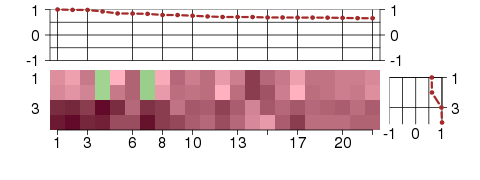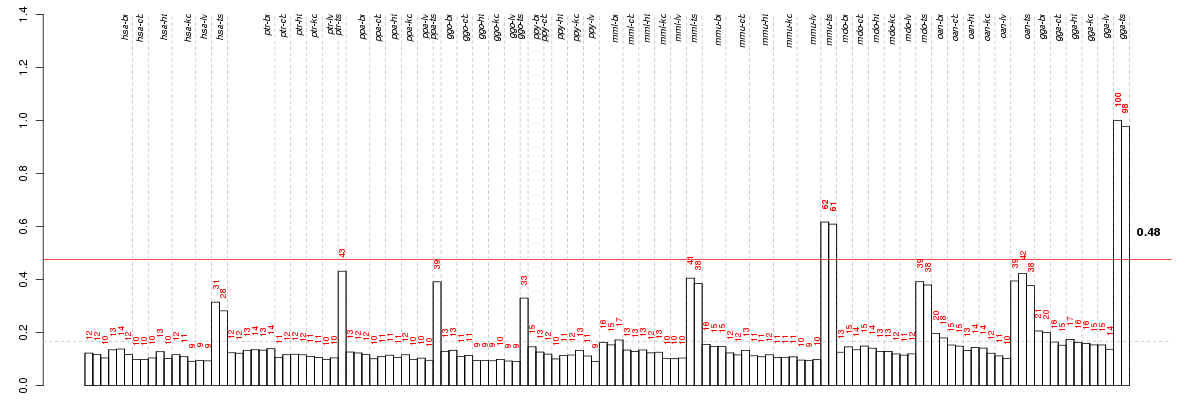



Under-expression is coded with green,
over-expression with red color.

multicellular organismal development
The biological process whose specific outcome is the progression of a multicellular organism over time from an initial condition (e.g. a zygote or a young adult) to a later condition (e.g. a multicellular animal or an aged adult).
biological_process
Any process specifically pertinent to the functioning of integrated living units: cells, tissues, organs, and organisms. A process is a collection of molecular events with a defined beginning and end.
multicellular organismal process
Any biological process, occurring at the level of a multicellular organism, pertinent to its function.
developmental process
A biological process whose specific outcome is the progression of an integrated living unit: an anatomical structure (which may be a subcellular structure, cell, tissue, or organ), or organism over time from an initial condition to a later condition.
organ development
Development of a tissue or tissues that work together to perform a specific function or functions. Development pertains to the process whose specific outcome is the progression of a structure over time, from its formation to the mature structure. Organs are commonly observed as visibly distinct structures, but may also exist as loosely associated clusters of cells that work together to perform a specific function or functions.
system development
The process whose specific outcome is the progression of an organismal system over time, from its formation to the mature structure. A system is a regularly interacting or interdependent group of organs or tissues that work together to carry out a given biological process.
anatomical structure development
The biological process whose specific outcome is the progression of an anatomical structure from an initial condition to its mature state. This process begins with the formation of the structure and ends with the mature structure, whatever form that may be including its natural destruction. An anatomical structure is any biological entity that occupies space and is distinguished from its surroundings. Anatomical structures can be macroscopic such as a carpel, or microscopic such as an acrosome.
all
NA
multicellular organismal development
The biological process whose specific outcome is the progression of a multicellular organism over time from an initial condition (e.g. a zygote or a young adult) to a later condition (e.g. a multicellular animal or an aged adult).
system development
The process whose specific outcome is the progression of an organismal system over time, from its formation to the mature structure. A system is a regularly interacting or interdependent group of organs or tissues that work together to carry out a given biological process.
organ development
Development of a tissue or tissues that work together to perform a specific function or functions. Development pertains to the process whose specific outcome is the progression of a structure over time, from its formation to the mature structure. Organs are commonly observed as visibly distinct structures, but may also exist as loosely associated clusters of cells that work together to perform a specific function or functions.


ANKFN1ankyrin-repeat and fibronectin type III domain containing 1 (ENSG00000153930), score: 0.71 ASPMasp (abnormal spindle) homolog, microcephaly associated (Drosophila) (ENSG00000066279), score: 0.67 CHRNA9cholinergic receptor, nicotinic, alpha 9 (ENSG00000174343), score: 0.69 CNOT4CCR4-NOT transcription complex, subunit 4 (ENSG00000080802), score: 0.73 CRYBA1crystallin, beta A1 (ENSG00000108255), score: 0.83 CXorf22chromosome X open reading frame 22 (ENSG00000165164), score: 0.78 FBXO47F-box protein 47 (ENSG00000204952), score: 0.66 KIF18Bkinesin family member 18B (ENSG00000186185), score: 0.84 KPNA6karyopherin alpha 6 (importin alpha 7) (ENSG00000025800), score: 0.76 LRRC67leucine rich repeat containing 67 (ENSG00000178125), score: 0.68 MYF5myogenic factor 5 (ENSG00000111049), score: 0.92 MYF6myogenic factor 6 (herculin) (ENSG00000111046), score: 0.98 NMBRneuromedin B receptor (ENSG00000135577), score: 0.78 RAG2recombination activating gene 2 (ENSG00000175097), score: 0.85 RFX6regulatory factor X, 6 (ENSG00000185002), score: 0.98 SPO11SPO11 meiotic protein covalently bound to DSB homolog (S. cerevisiae) (ENSG00000054796), score: 0.7 STRA8stimulated by retinoic acid gene 8 homolog (mouse) (ENSG00000146857), score: 0.69 TLX1T-cell leukemia homeobox 1 (ENSG00000107807), score: 1 TP63tumor protein p63 (ENSG00000073282), score: 0.68 TSGA14testis specific, 14 (ENSG00000106477), score: 0.66 VASH2vasohibin 2 (ENSG00000143494), score: 0.68
| Id | species | tissue | sex | individual |
|---|---|---|---|---|
| mmu_ts_m2_ca1 | mmu | ts | m | 2 |
| mmu_ts_m1_ca1 | mmu | ts | m | 1 |
| gga_ts_m2_ca1 | gga | ts | m | 2 |
| gga_ts_m1_ca1 | gga | ts | m | 1 |
